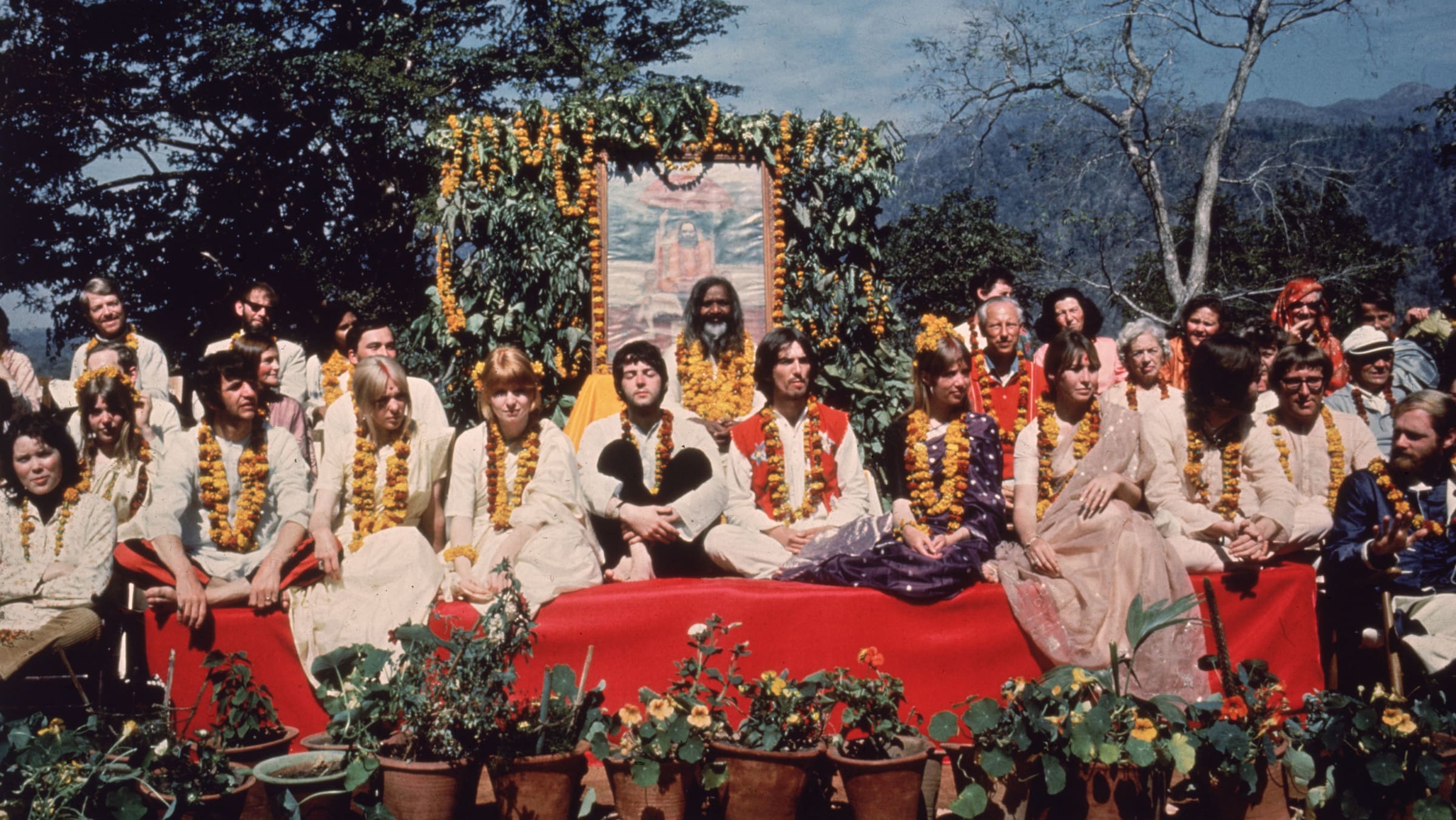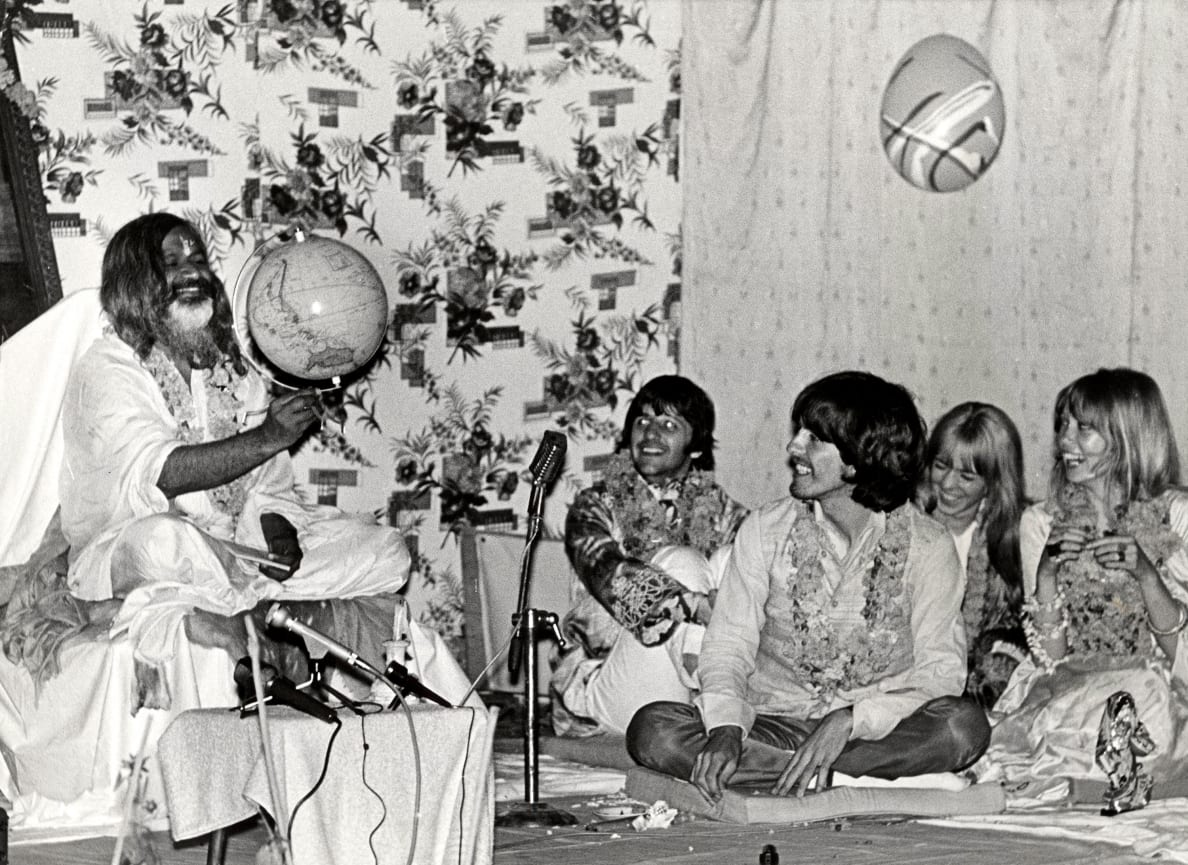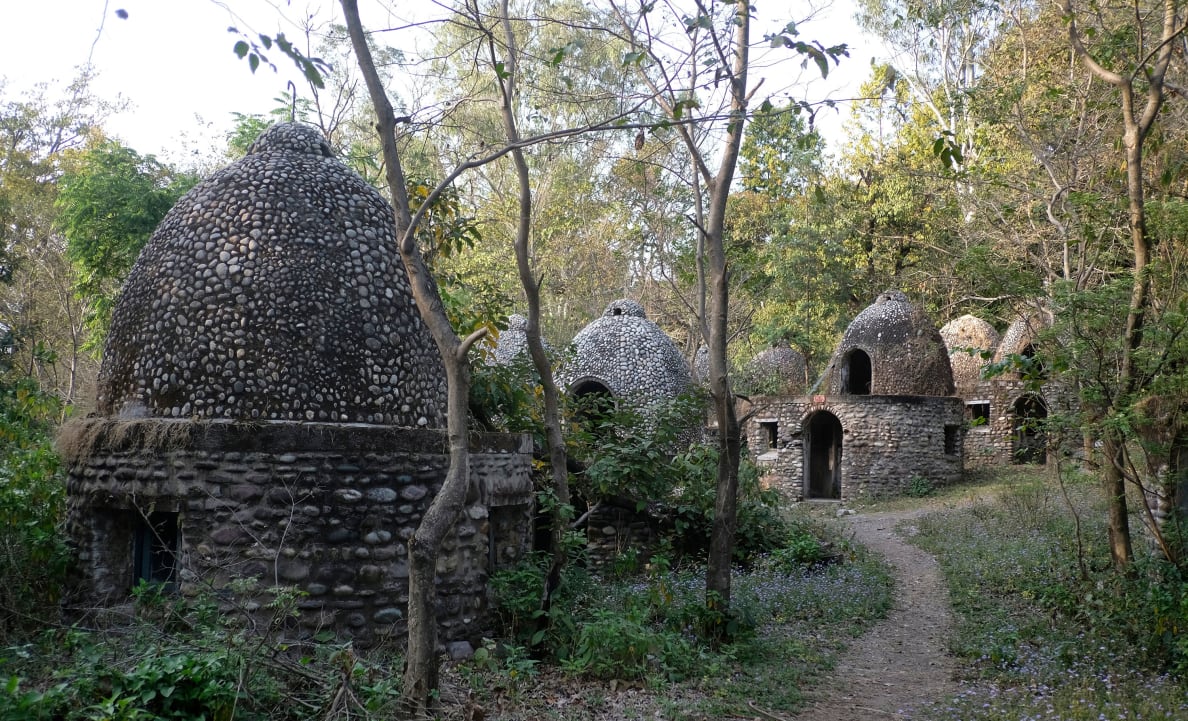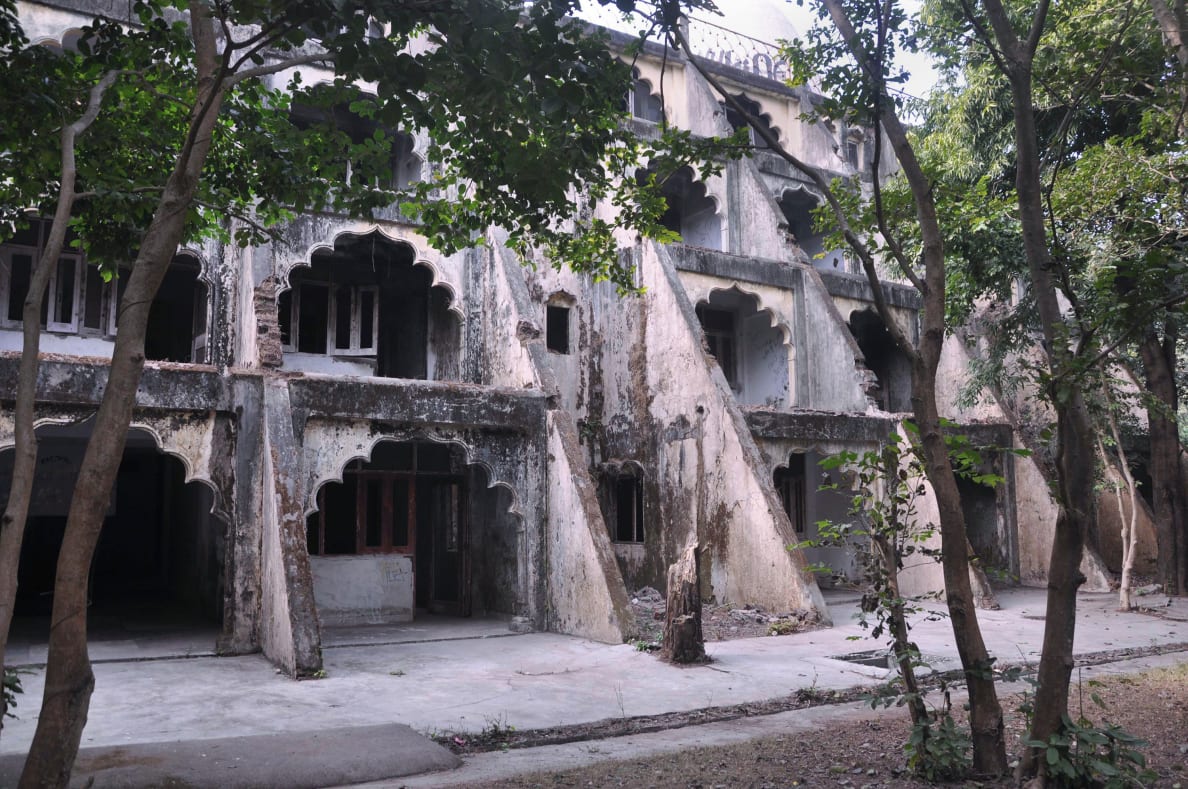
THERE ARE PLACES I REMEMBER
Inside the Abandoned Beatles Ashram in India

Hulton Archive/Getty
The Beatles all tried to find Nirvana here on their trip to India, as did Mia Farrow and other celebrities. But the ashram turned out a bust, and for decades has been left alone.
Rishikesh beckons. Nestled in the verdant foothills of the Himalayas, the holy town in north India sparkles like a jewel in the hazy afternoon sky. To get there, I have to cross a narrow suspension bridge called Lakshman Jhula. It sways above the sacred jade waters of the Ganges, which is believed to wash away all sins.
As I step onto the bridge, it feels like all of humanity has converged here. The pathway is jammed with motorbikes, seekers, tourists, backpackers and yogis, sadhus in saffron robes. Cows amble toward me. Monkeys stare. Men spit. On the opposite side, ashrams and temples hug the river where worshippers pray, chant, and bathe. With their bright colors and fanciful shapes, they look like something a child would create.

Suspension bridge across a river with Trayambakeswar temple in the background, Lakshman Jhula, Rishikesh, Dehradun District, Uttarakhand, India.
Exotica.im/UIG via Getty
I have come to Rishikesh, a world-renowned yoga center, on a pilgrimage of sorts. I am here to find the Beatles Ashram. In February 1968, the Beatles ventured to this remote corner of India to study Transcendental Meditation with the Maharishi Mahesh Yogi, its founder.
I was a teenage girl then, in love with George, his sad, dark eyes and soulful guitar playing. The band journeyed to India at the height of their celebrity. Bereft at the death of their manager Brian Epstein, and bickering among themselves, the four British musicians hoped to find spiritual guidance.
They did not, alas, find nirvana. Ringo left after about 10 days, unsettled by the spicy food. Paul soon followed. Two months later, George and John abruptly fled, after the guru’s materialism and less-than-holy sex life became evident. But not before writing many of their songs for the collection that came to be known as The White Album: “Ob-La-Di, Ob-La-Da,” “Blackbird,” and “Dear Prudence,” after Mia Farrow’s sister, Prudence, who stayed at the ashram then. Mia did, too.

Maharishi Mahesh Yogi, George Harrison, and Ringo Starr at a party to celebrate Harrison’s 25th birthday at Rishikesh, India, Feb. 25, 1968.
Cummings Archives/Redferns/Getty
For decades the ashram was abandoned, its gates shuttered, its forest grounds unkempt. Fans and lovers occasionally stole in to scrawl their names in the empty buildings. Then, a few years ago, inspired by the rise in ecotourism, the property inside Rajaji National Park was reopened to visitors. A small café was added, and a gallery to showcase photography of the Beatles’ 1968 visit.
I did not know where the ashram was, and had no address. So Sunita, a river guide at Atali Ganga, the stunning eco-lodge where I stayed, agreed to take me.
As we make our way through the narrow lanes, we weave around stray dogs, blaring taxis and knots of tourists. We pass cafés, ashrams teaching yoga classes and meditation, centers offering Ayurvedic healing.
Every March, thousands of yogis descend on Rishikesh for the International Yoga Festival. Even now, in early December, there is almost too much to see, to take in. As we walk through the heart of town, I get constantly distracted.
In one open-air stall, I buy a fistful of colorful cotton scarves for $2 apiece. I walk past a small shop selling organic Indian spices, and duck in to smell them. In another, I flip through CDs of contemporary Indian music. In a store filled with semi-precious gemstone jewelry and religious totems, a Tibetan man sits on a stool holding a baby, swaddled in fleece. I kneel down and smile at her. I leave with a pair of Tibetan copper bells.
Street vendors and restaurants serving vegetarian dishes are plentiful. Alcohol and meat are not allowed in Rishikesh. Cows are deemed so holy that, in some regions of India, Hindu extremists have murdered farmers for killing the animals. Cows are everywhere. Lying across storefronts. Roaming the lanes. Snoozing in doorways. Some have their horns painted royal blue.
After walking south through the city for an hour, the chaos fades as we enter a peaceful residential area. We walk on a stone path skirting the Ganges, turn a corner onto a dry river bed. Then suddenly we are at the ashram gates. Save for the forest guard in the kiosk, and an Indian couple, the place is deserted. I pay the entrance fee of 600 rupees, and walk uphill past a stone wall painted with gold and scarlet butterflies.

The meditation cellars in the ashram where the Beatles stayed in 1968 on March 27, 2017, in Rishikesh, India.
Virginie Clavieres/Paris Match via Getty
The ashram sprawls across 14 acres, a legacy of nature, art, and the spiritual counterculture of the 1960s. The place is spooky, beautiful. Peacocks wander the grounds. The only sound is their cries, or the rustle of monkeys in the sal forest. Cobwebs float inside the desiccated buildings. The Indian government plans to renovate them, but not much has been done.
I enter a massive, high-ceilinged lecture hall and gasp. The walls are covered in pop art, graffiti, images of the Maharishi, and murals of the Beatles painted by street artist Pan Trinity Das and a group of friends, over several visits to the ashram beginning in 2012. This is the magical Beatles Cathedral Gallery, a frequent stop for their fans in India. I stand in the hall, close my eyes and listen. It’s been more than 50 years since the musicians came to Rishikesh. John and George are long gone. But it feels like their spirits remain.
When the Maharishi envisioned the ashram, using land leased from the Uttar Pradesh Forest and Wildlife Department, he didn’t exactly scrimp. There’s a post office, a communal kitchen, a printing press, residence halls, a meeting room where disciples played music, meditated and chanted. George practiced sitar in a glass-domed gazebo. The Maharishi lived in a compound above the Ganges.
The most striking buildings are the stone meditation huts—84 of them—sprinkled across the leafy grounds. They look like gray eggs. Inside some of them, steps lead down to another floor. For an hour, I wander in and out of the huts, spellbound. In one, I sit cross-legged in the wide-open doorway and contemplate who might have meditated here. Remnants of fixtures litter the floor. Inside, the paint on the once vibrant walls is cracked, faded. One, painted orange, makes me think of “marmalade skies.”

In this photograph taken on Dec. 8, 2015, dwellings are pictured at the Beatles ashram, as the former ashram of the self-styled guru Maharishi Mahesh Yogi is known, in Rishikesh.
STR/AFP/Getty
Before night falls, I make one last stop, at the gallery exhibiting photographs of the Beatles during their time at the ashram. Taken by Paul Saltzman, the author of a 2018 book called The Beatles in India, the photos are mostly group shots of the band, posing with Cynthia Lennon, Jane Asher, Pattie Harrison Boyd, Mia Farrow, Donovan, and other devotees. They look so young, George and John, Ringo and Paul, in their loose white shirts and pants, a garland of marigolds around their necks, their faces serious. In one group picture, the Maharishi sits above them, his hands clasped in his lap. He has long gray hair, a white beard, and a slight smile on his lips. I wonder what the guru is thinking? He died in his sleep in the Netherlands in 2008, a week after relinquishing his role as leader of the TM movement, the whispers over his sexual misdeeds and materialism largely forgotten. He was given a state funeral at his ashram in Allahabad, India, overlooking the Ganges.
I wish I could have visited the ashram when the Beatles were here. But in some ways, it wouldn’t have been as meaningful as my vigil there decades later. I wouldn’t have yet endlessly listened to “Norwegian Wood,” or the other timeless songs they composed during their stay.

No comments:
Post a Comment